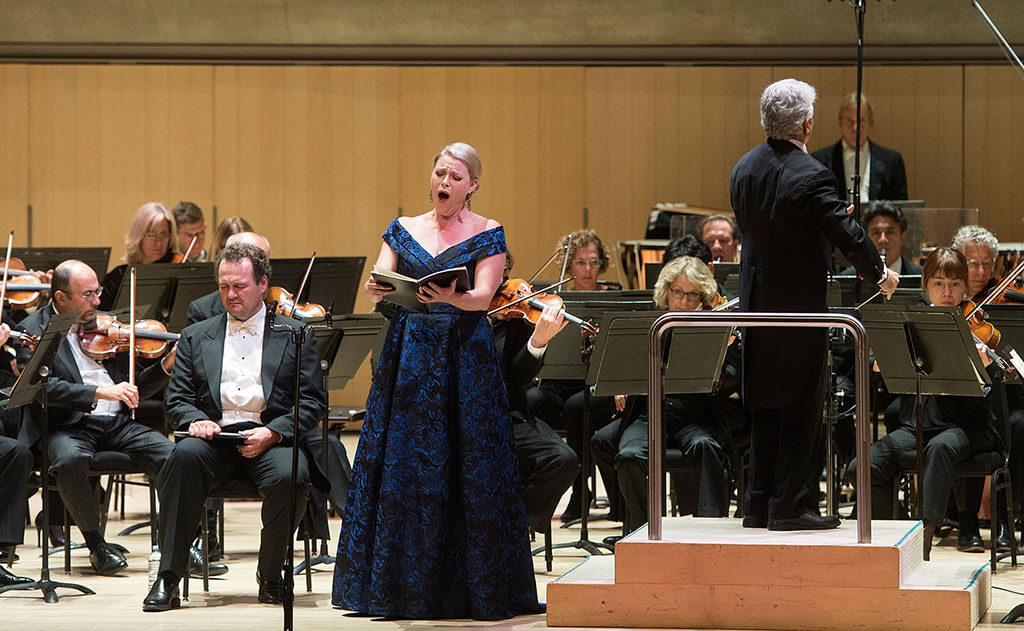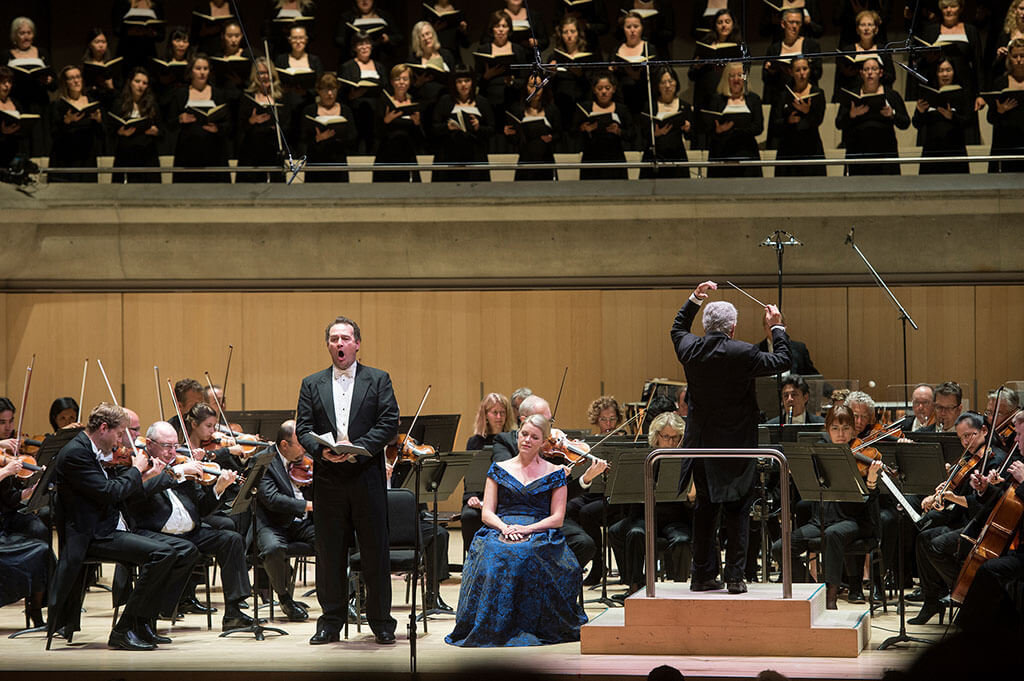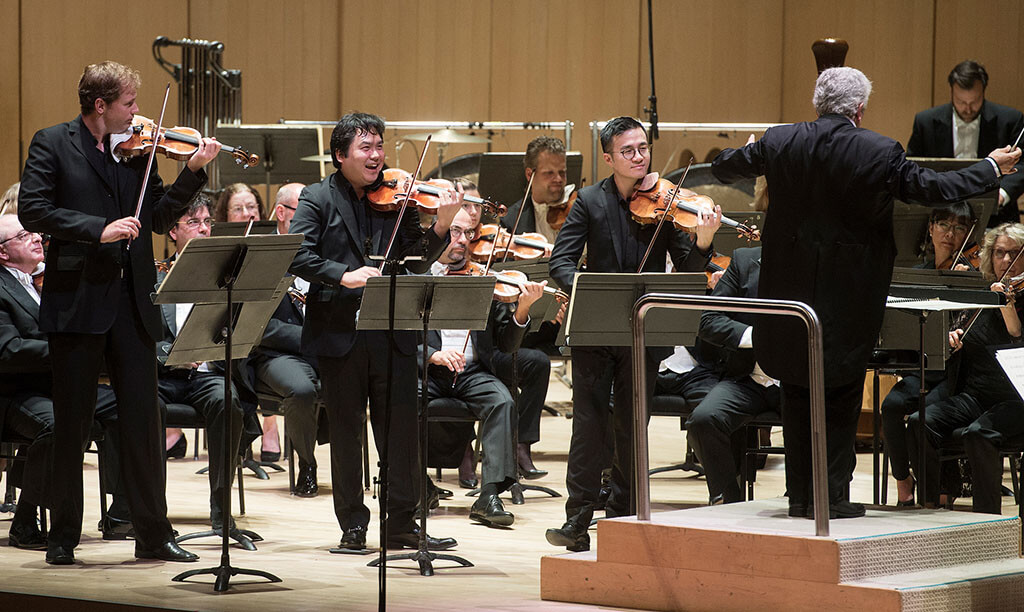
Brahms German Requiem: Toronto Symphony Orchestra and the Toronto Mendelssohn Choir; Erin Wall (soprano), Russell Braun (baritone), Peter Oundjian (conductor) at Roy Thomson Hall — Wednesday, Sept. 27. (repeats Thursday, Sept. 28, and Saturday, Sept. 30)
Peter Oundjian brought Ein deutsches Requiem back to the stage of Roy Thomson Hall after only four years and a bit, possibly because the conductor felt he had something more to say about Brahms’s choral masterpiece. And so he did Wednesday in the first of three Toronto Symphony Orchestra performances with Toronto Mendelssohn Choir.
The latter ensemble of about 130 as prepared by Noel Edison furnished what a devout listener might call a firm foundation, confidently projected yet carefully balanced. The Mendelssohnians are about three-fifths female, and generally sound it, but there was no difficulty in hearing the gentlemen in Brahms’s fugues, which came across as urgent and stirring rather than academic. Words were admirably clear.
Seriously understated in 2013, Oundjian added more substance to the sonic blend on this occasion and pressed Brahms’s prevailingly moderate tempos gently forward rather than holding them back. Not that this 73-minute performance was hasty or lacking in apocalyptic drama in the sixth movement, which earned some understandable intrusive applause. The dead are not raised incorruptible every day.

Baritone Russell Braun was, of course, central to the success of this episode. If this Canadian’s voice is neither especially voluminous nor richly coloured, it is carried with consistent nobility. His compatriot Erin Wall applied a big, broad soprano to the prior movement and also earned a little burst of clapping.
The orchestra, which last week proved itself a much-more-than-decent Brahms band, was at it again, creating a sonority built distinctly from the bottom up. Trombones were handsome (the last trumpet, for Martin Luther, was a trombone) and the organ functioned impressively as a binding agent.
What to offer alongside this magnificent work is something of a conundrum. Oundjian opted for contrast rather than complementarity by presenting the premiere of Alexina Louie’s Triple Concerto for Three Violins and Orchestra with a troika of central-Canadian concertmasters as soloists.

As the Toronto composer explained in her notes, she wished to create a work for equal partners, and such in general was the effect, even if Andrew Wan of the Montreal Symphony Orchestra was the first to articulate the rising principal theme, followed in short order by Yosuke Kawasaki of the National Arts Centre Orchestra and Jonathan Crow of the TSO.
Much of the tranquillo first movement found the soloists mingling with the full orchestra. Louie is a big-canvas colourist by nature. In the energetic second movement, the soloists distinguished themselves from the pack, often by speaking together. It says something about the skill of the composer that the persistent rhythm expanded into something more spacious just when I wanted such a shift.
Might there have been a way of letting each of the concertmasters speak with more of an independent voice? The TSO, MSO and NACO are credited as co-commissioners of the music. Presumably, we can look forward to more performances and possibly some balance adjustments.
This Canada Mosaic program began with the mandatory two-minute Sesquie. Much of Rolf Boon’s Hyacinth Caelum, representing a Sibelian sunrise over Lethbridge, Alberta was scored for brass and percussion, and indeed might work better in a band arrangement. Another Sesquie, by Jared Miller, is heard in the repeat of Thursday. The Saturday performance is Sesquie-free.
#LUDWIGVAN
Want more updates on Toronto-centric classical music news and reviews before anyone else finds out? Follow us on Facebook or Twitter for all the latest.
- SCRUTINY | Moussa Concerto Sounds Strong In Toronto Symphony Orchestra Premiere, Paired With Playful Don Quixote - April 4, 2024
- SCRUTINY | Esprit Orchestra At Koerner Hall: Ligeti 2, Richter No Score - April 1, 2024
- SCRUTINY | Sibelius & New Cello Concerto By Detlev Glanert Offers A Mixed Bag From The TSO - March 28, 2024



